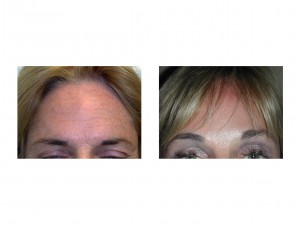
Facial volume restoration is partly an extension of the popularity of commercially available injectable fillers, such as Juvederm, Radiesse and Sculptra. While very effective for small linear volume deficiencies such as the nasolabial folds and the lips, their cost and material properties limit their value in large volume replacements. Beside the cost, the temporary nature of these injectable fillers is also a disadvantage when significant volume is needed.
The real galvanizingtechnique for volume restoration in the upper face is fat injections. Besides the need to have a limited invasive harvesting, it has most of the ideal requirements for a facial filler. It is both natural, plentiful (in most people) and has a chance to be permanent.
The upper third of the face is usually the first to show the signs of facial aging, often occurring in the mid- to late thirties. The brows can drop, excess skin forms on the eyelids and wrinkles develop in the forehead. Volume loss is not typically associated with aging in this part of the face but it can be for many patients.
The biggest area of volume loss in the upper face is the temporal region. Some patients will develop significant atrophy of the underlying fad resulting ina hollowed skeletonized look. The sunken in temporal region creates very easily seen transitions to the zygomatic arch below and the lateral orbital rim in front. Volume is restored by fat injections which are done through a single entry point behind the temporal hairline. There are numerous planes to inject into including intramuscular, subfascial or on top of the muscle, or on top of the fascia. No one has proven that one temple injection plane is better than the other. Currently I prefer the subfascial plane because of its proximity to very vascularized muscle. Volumes of 3 to 10ccs may be needed to make a noticeable change.
Changes in the brows and eyelids are the most recognizeable age-related changes including sagging of the brows and excess upper eyelid skin. Volume loss is seen in the deep upper eyelid sulcus, the tear trough of the lower eyelid and loss of fullness in the brow area. In the younger patient, fat injections alone may be enough. In other patients, fat transfer is combined with blepharoplasty and/or browlift surgery. Fat injections are done through a single entry point in the lateral canthal skin crease. This allows the fat to be injected along the brow right next to the bone and just under the skin in the upper eyelid. No more than 1 to 3ccs of fat is needed. Some minor amount of browlifting can be achieved if some fat is injected just right below the brow area. More fat should be placed in the lateral two-thirds of the brow to create a more youthful appearance. A separate entrance point is needed to inject the glabellar furrows which may or may not be combined with Botox injections.
The tear troughs of the lower eyelids are ideal for fat injections. Some people have them congenitally at a young age and many develop them as lower eyelid fat herniation becomes more severe. Injecting fat along the lower orbital rim bone is done with a greater volume at the inner aspect. Using a curved injection cannula trough the lateral canthal entrance is a helpful technique. One to two ccs is all that is usually needed.
Dr. Barry Eppley
Indianapolis, Indiana


